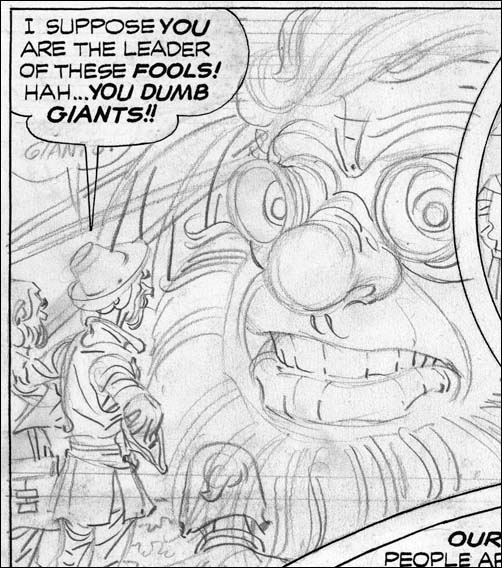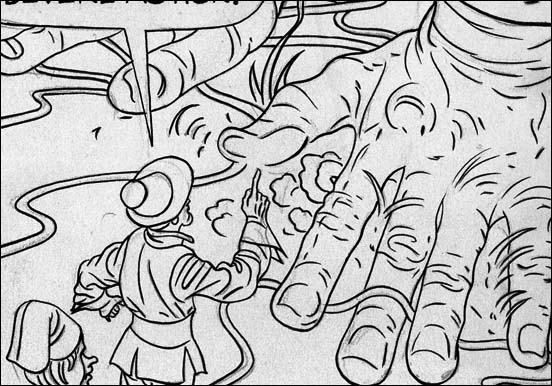Most of the work by Jack Kirby that people admire they only know second hand. They know Kirby inked by Dick Ayers, or Kirby inked by Joe Sinnott, or Kirby inked by Mike Royer, and so on. By its very nature this means we are seeing various artists’ interpretations of Kirby’s pencils. Even in his late years when Jack pencil’s provided indications of how the spotting should be done and inkers tried to be faithful to the pencils, it is still an inker’s interpretation. This is the state of affairs during Jack’s more recent career when he did extremely little inking.
Earlier, during the Simon and Kirby years, things were very different. Most, if not all, of the S&K studio artists inked their own work. The inking style for each artist seem unique and consistent. Most did not produce enough output to support heavy use of assistants. Mort Meskin was more prolific so perhaps he was an exception. However for Jack Kirby we have some eye witnesses such as Martin Thall who have reported group inking sessions at the S&K studio. Examinations of the finished product adds support to this because often different hands seem involved. However other observers such as Carmine Infantino have reported Kirby providing the final inking touches to his own work. Who inked what is often the subject of contentious debate since the comics do not provide credits and comic book experts rarely provide explanations for their attributions. Someday I may wade in with my own inking attributions, and even explain why, but this is not that day.
After the breakup of the S&K Studio Jack began to do freelance work. We find Kirby work published by DC, Atlas and Prize. Among the early freelance period I see some consistencies in the inking that indicate one hand at work, I think we can rule out Joe Simon since there is no evidence that he ever did any work at this time for DC or Atlas. Further the style is dissimilar to the inking found on some of Simon’s own work of the period. Nor does the inking style match that by artists who in the past did work for S&K such as Mort Meskin, Bill Draut or Marvin Stein. The spotting is done with enough talent that I think we can rule out some new, unknown inker. Besides which although at times Jack might have been doing enough penciling to support an inking assistant this changed. Kirby began to supply DC and Atlas with just penciled art with the publisher assigning the inking to others. After that this inking style only appears in Prize’s Young Romance and that was not enough work for Jack to support any inking help. My conclusion is that this inking style was Kirby doing his own inking. As such it provides a rare opportunity to see Kirby first hand.
I have mentioned this inking style previously. Once when I was discussing the break up of Simon and Kirby. Again more recently when I posted on The Black Rider Rides Again. I think it might be interesting to examine the evolution of this inking style. To do so I needed to give it some sort of designation. I thought of referring to it as Kirby’s late inking style but I suspect that is too confusing. The inking may be late in his inking career since it was the last style that Jack used while he still commonly had a hand in inking his own work. But Kirby had a long career and using a term such as “late” to describe a period that ended in 1959 just seems inappropriate. So I am going to call it Kirby’s Austere Style of inking because of its typical lack of embellishments.
To understand the development of the Austere Style is really helps to go back to what it evolved from. I think the best place to start is toward the end of the Simon and Kirby studio. But like an old adage, to tell that story I have to tell another story. I need to describe how inking of Kirby pencils was done in the S&K studio. This is a very different topic from who did the inking.
Pages of S&K art went through distinct stages. These stages are known because sometimes comics book titles were unexpectedly cancelled. When this happened work on future issues was already in progress. Work on any of these cancelled titles would immediately stopped no matter what stage it was in. Sometimes the art could be salvaged for other projects, but not always. Not a lot of these unfinished pages survived but what has tells a consistent story.
The first stage was, of course, the penciling. This included rough placement for the work balloons and captions. Some covers in this stage have been published in The Jack Kirby Collector. But the rough placing of balloons can be observed even when a page has advanced to further stages because it often was not completely erased.

Boys Explorers (unpublished) art by Jack Kirby
Next the lettering was done along with inking of the word balloons and the panel borders. It is in this stage that most unfinished pages are found and it is the stage that I can provide an image. Note that Kirby’s pencils are still uninked. Jack’s drawing is pretty tight but he does not shown any indication of how blacks are to be arranged. Outlines are provided and the folds of the clothing is indicated by simple lines. On one hand the inker was given clear indications of where ink lines should be applied. On the other hand application of black areas, what is called spotting, was completely left up to the inker.

Boys Explorers (unpublished) art by Jack Kirby
For the third stage line inking was done. Since for the most part Kirby’s pencils were tight this required little more then the ability to carefully follow Jack’s lines. This meant that finesse with the inking pen or brush was more important then artistic ability. I suspect that often the outline inking was done by studio assistants and after the studio breakup even by Kirby’s wife Roz. Sometimes there seems to have been no real attempt to adjust the width of the inked lines. In the example I provide above it is almost as if the outlines were made by bending wire. If the outline required any emphasis it could be introduced in the next stage. We shall see in the next chapter that a more artistic inking of the outlines would sometimes be done.
The final stage, known as spotting, supplied the blacks to the image. As remarked above there really was nothing in the pencils to indicate how this should be done. For good results a talented inker would be required. But it is a simplification to call this one stage. Particular spotting chores, such as foliage or backgrounds, could be assigned to different artists. However there did not seem to be any fixed procedure for how or by whom this was done. Jack, Joe or both could do the final touch ups.
S&K studio inking was a different thing altogether then how inking was handled in the Silver Age and beyond. Then the penciler’s work was handed over to another artist who would provide all the inking. Under such a system it makes sense to say a particular piece was drawn by Jack Kirby and inked by say Dick Ayers. Unfortunately people apply the same terminology to Simon and Kirby art. When they say a Kirby piece was inked by say Joe Simon what do they really mean? That the Joe did all the work, both outline and spotting? Or that he did just the spotting? Or could it be that Joe’s did some spotting along with others? Generally I try to be specific about what type of inking I am talking about.
Jack Kirby’s Austere Inking, Chapter 2, Mainline
Jack Kirby’s Austere Inking, Chapter 3, A Lot of Romance
Jack Kirby’s Austere Inking, Chapter 4, Prize Covers
Jack Kirby’s Austere Inking, Chapter 5, Harvey
Jack Kirby’s Austere Inking, Chapter 6, Atlas
Jack Kirby’s Austere Inking, Chapter 7, DC
Jack Kirby’s Austere Inking, Chapter 8, More Harvey
Jack Kirby’s Austere Inking, Chapter 9, More Prize
Jack Kirby’s Austere Inking, A Checklist and a Glossary
other post with Kirby inking Kirby:
Strange Tale Indeed
Battleground, Jack Kirby’s Return to Atlas
Captain 3D


Hi Harry,
Interesting subject, we also know that there were books such as Captain 3D which featured many hands in the inking stage. Do we know how much “Inky” Roussos was doing? Has he ever listed which books or artists he worked on and with?
What other primarily inkers were at S&K, if any? Did Meskin ink other artists? I’m sure he inked Kirby at times. What about Premiani?
Does Joe mention his own inking and how to identify it?
Stan
Stan,
Can’t say much about Roussos or Prermiani but in future chapters I will be providing some examples of Kirby inked by Meskin, Draut and Simon. And of course a lot of Kirby on Kirby, the primary theme of this serial post.
I do not believe I have ever seen an example of any artist working for S&K being inked by another S&K artist. That does of course exclude Jack or Joe taking on the roll of art editor and fixing up work by other artists. Most S&K artists did not work in the actual studio and were paid for the work they supplied. Therefore it is not surprising that they inked their own work.
Meskin did work in the studio so it is possible that he might have gotten help with outline inking. But all the spot inking on Meskin looks like the same hand which I assume is Meskin himself. But he was prolific enough that it is possible he had his own ghost assistant.
I am sorry to say Joe Simon is not much help in inking attributions. Some very few pieces of original art from his collection have inking attributions written on them. But frankly I believe they were later additions by some comic expert and are opinions not fact.
Harry